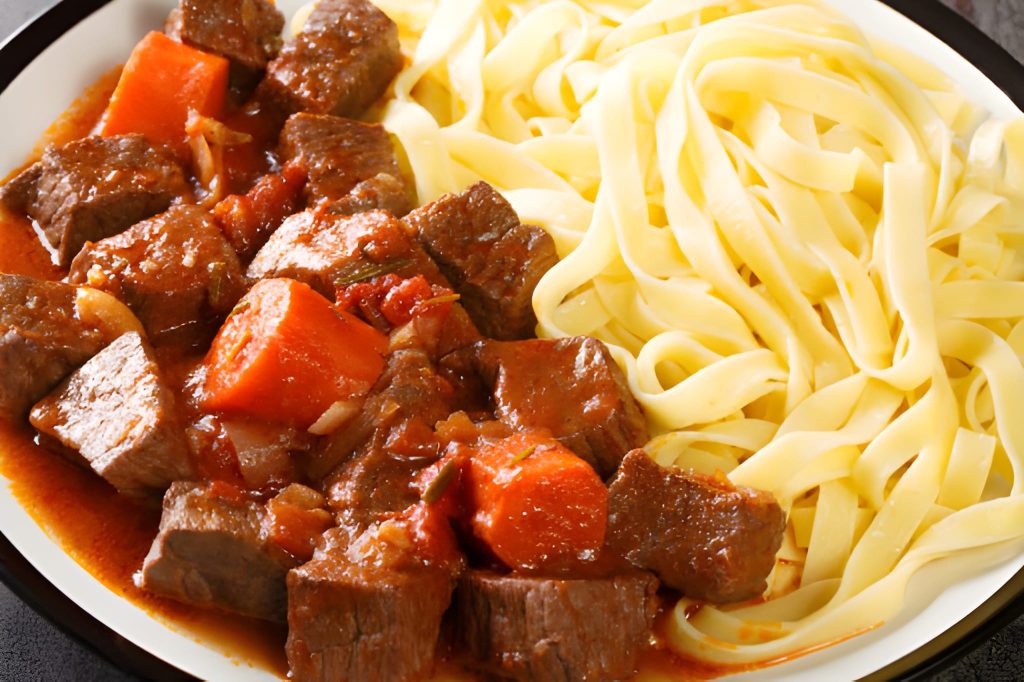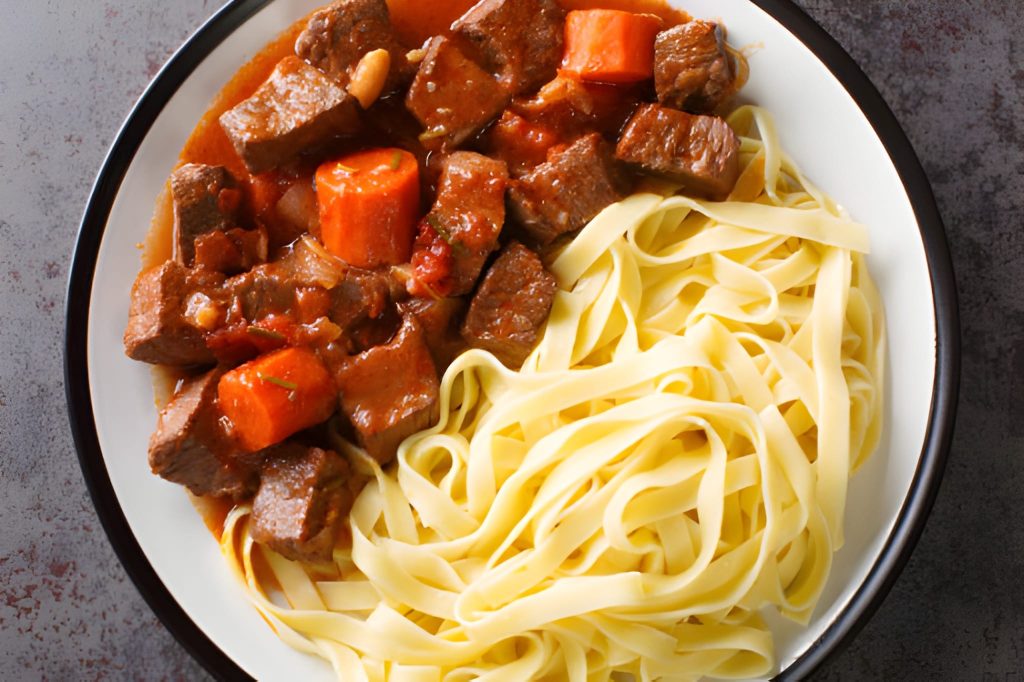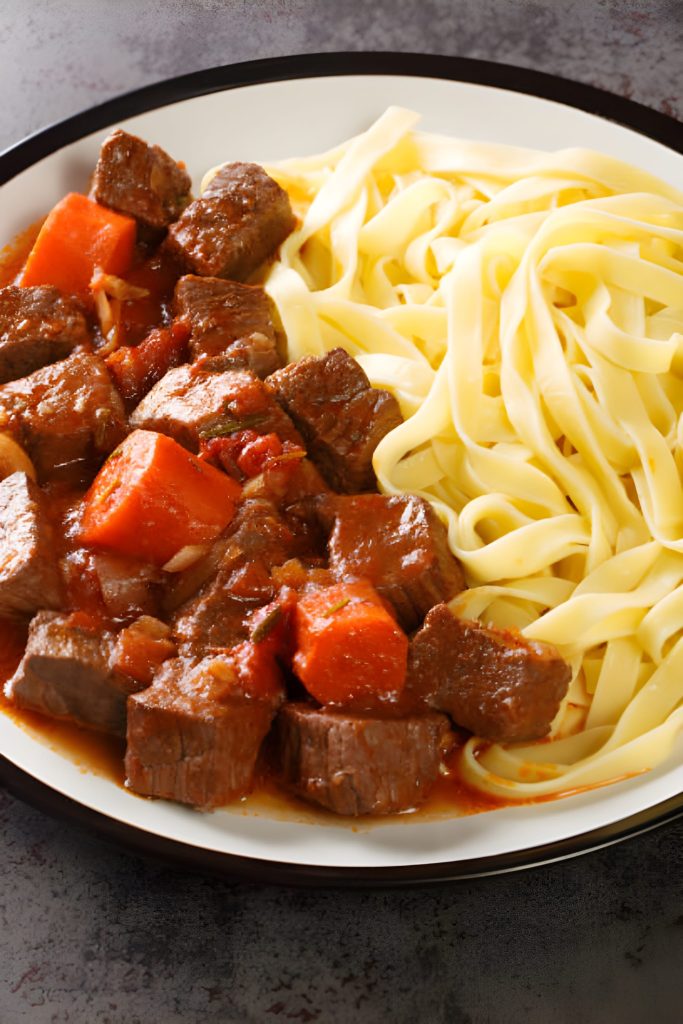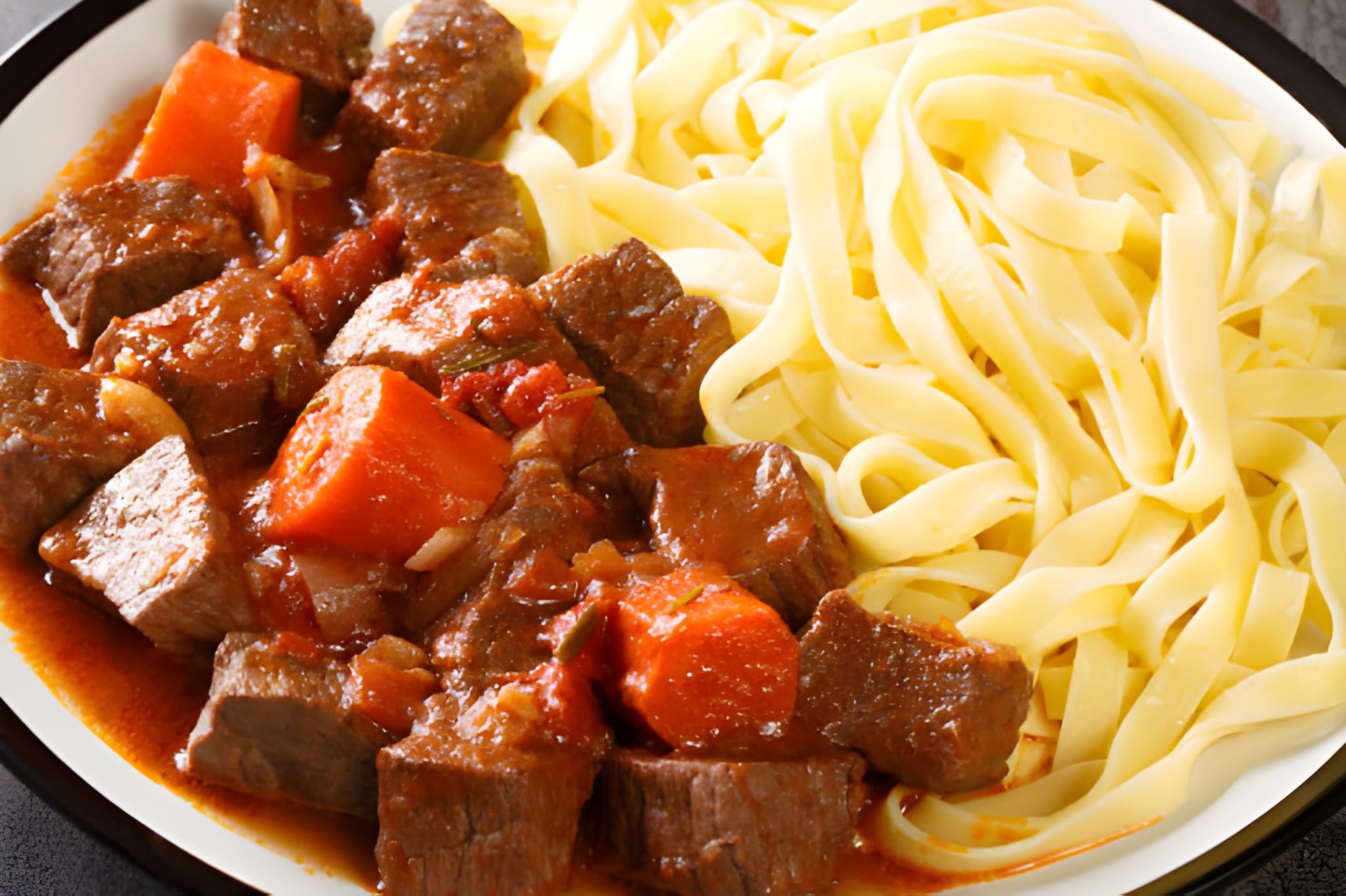Patricia Beef Daube Recipe
Few dishes capture the warmth and comfort of rustic French cooking quite like Patricia’s Beef Daube. Slowly simmered in white wine with aromatic herbs, tender beef, and rich tomatoes, this hearty stew fills the kitchen with deep, savory aromas that promise pure satisfaction. Each bite delivers melt-in-your-mouth beef surrounded by a velvety sauce layered with subtle acidity and herbal depth. Whether shared during an intimate family dinner or served as the centerpiece of a special gathering, this dish transforms simple ingredients into something truly luxurious.

Ingredient Breakdown
The quality of the beef defines the entire dish. Cuts like chuck, shoulder, or brisket are ideal for slow braising because their marbled texture softens into tenderness over time, creating a stew that practically dissolves on the tongue. Choosing these cuts ensures the meat remains flavorful while enriching the sauce with natural juices.
The aromatic base forms the foundation of flavor. Onions, garlic, and olive oil gently sautéed together create a sweet and savory undertone that anchors the entire dish. Their caramelized edges lend a richness that balances the acidity of the wine and tomatoes later added to the pot.
Dry white wine and Dijon mustard work together to create remarkable depth and balance. The wine adds brightness and a slight tang, cutting through the richness of the beef, while the mustard brings sharpness and creaminess that melt seamlessly into the stew. Canned plum tomatoes, crushed by hand, add body and subtle sweetness, making the sauce both hearty and refined.
The bouquet garni—an aromatic bundle of thyme, tarragon, parsley, and bay leaves—infuses the stew with an herbaceous complexity as it simmers. It perfumes the sauce gently, blending into the background while elevating the flavor to something sophisticated and deeply comforting. For those who enjoy added sweetness and color, sliced carrots bring an extra layer of warmth and heartiness to the dish, complementing the savory depth of the beef.
Step-by-Step Preparation Guide
The secret to a perfect daube begins with searing the beef properly. Taking the time to brown each piece evenly develops a deep, golden crust that locks in juices and lays down a flavorful base for the sauce. Patience here pays off—the caramelized bits left behind form the essence of the dish.
Deglazing the pan with wine is where the magic happens. As the liquid bubbles, it releases all the browned remnants from the bottom, enriching the stew with concentrated flavor. A few minutes of reduction intensifies the aroma while mellowing the wine’s acidity, setting the stage for the addition of mustard and tomatoes.
Once all the ingredients come together, the stew must simmer slowly. A low, steady heat transforms the tough fibers of the beef into tender morsels, while the liquid thickens into a rich, silky sauce. This gentle cooking process ensures every bite carries balanced flavor and melt-in-your-mouth texture.
When the beef is done, reducing the sauce is key to achieving that glossy finish. Boiling it briefly evaporates excess liquid, concentrating the flavors into something bold and luxurious. If carrots are added, this is the perfect moment—they absorb the sauce beautifully and add a pleasant touch of sweetness.
The final step brings everything together. The tender beef and softened vegetables are returned to the pot, coated in the thickened sauce, and gently reheated. The result is a stew that’s cohesive, aromatic, and deeply satisfying—ready to serve straight from the pot to the table.

Recipe Tips & Frequently Asked Questions
Selecting the ideal beef cuts for tenderness and rich flavor:
Opt for well-marbled cuts like chuck or brisket that can withstand long cooking without drying out.
Adjusting the wine and mustard ratio for preferred sharpness:
For a softer flavor, use a slightly sweeter white wine or reduce the mustard by half. For more tang, increase the mustard or add a splash of lemon juice at the end.
How to keep the stew at a gentle simmer without drying the meat:
Maintain a low flame and ensure the lid stays slightly ajar to allow slow evaporation while retaining moisture.
Techniques to thicken the sauce naturally without flour or cornstarch:
Allow the sauce to reduce uncovered for 10–15 minutes; the natural gelatin from the beef will create a thick, velvety consistency.
Storing and reheating leftovers to maintain texture and taste:
Refrigerate for up to three days; the flavor deepens overnight. Reheat slowly on the stove, adding a splash of broth or water if the sauce thickens too much.
Can I make this stew ahead of time?
Yes, it actually tastes better the next day as the flavors meld beautifully.
Is it possible to use red wine instead of white?
Absolutely—red wine will give the stew a bolder, more robust flavor profile.
How long can I store Beef Daube in the refrigerator?
Up to three days; for longer storage, freeze it for up to three months.
What can I substitute for Dijon mustard?
A blend of whole-grain mustard and a touch of vinegar works well in its place.
Can this recipe be adapted for a slow cooker or Instant Pot?
Yes—sear the beef first, then transfer to a slow cooker for 6–8 hours on low or pressure cook for 45 minutes for a quicker version.
What to Serve With This Recipe
Patricia Beef Daube pairs wonderfully with creamy mashed potatoes that soak up the luxurious sauce. Buttered egg noodles or velvety polenta make equally comforting companions, offering a soft contrast to the rich stew. For texture, a crusty baguette or slice of artisan bread is essential to mop up every last bit of sauce.
Balance the richness with elegant side dishes like green beans almondine, sautéed spinach, or a crisp mixed salad dressed lightly with lemon vinaigrette. A glass of wine makes the experience complete—choose a dry white such as Chardonnay to mirror the stew’s flavors, or a full-bodied red like Syrah for a more robust pairing.
Creative Variations
For a deeper, earthier version, add root vegetables like parsnips or turnips alongside the carrots. For a Provençal twist, stir in black olives and mushrooms during the final simmer to infuse the dish with Mediterranean character. If you prefer a richer, more indulgent variation, try substituting the stewing beef with short ribs or lamb—each adds its own layer of complexity while keeping the essence of slow-cooked comfort.
Patricia Beef Daube is a celebration of patience and craft—a stew that rewards slow cooking with layers of complex, comforting flavor. From its tender beef to its glossy, herb-infused sauce, every element reflects the soul of French home cooking. It’s a dish that feels timeless and elegant, yet approachable enough to make any evening feel special. Whether served on a chilly night or shared at a festive table, this daube brings warmth, aroma, and pure satisfaction to every plate.

Ingredients
2 lbs stewing beef, cut into 2-inch chunks (shoulder, chuck, blade, neck, rump, or brisket recommended)
3 Tbsp olive oil
2 medium yellow onions, thinly sliced
1 bottle dry white wine (such as Chardonnay)
16 ounces canned plum tomatoes, with juices
2 Tbsp Dijon mustard
3 cloves garlic, peeled and lightly smashed
Salt and freshly cracked black pepper, to taste
1 bouquet garni (parsley, thyme, tarragon, and bay leaves tied with kitchen string)
Optional: 6 carrots, peeled and cut into batons
Instructions
Peel the onions and slice them thinly, first halving them lengthwise, then cutting crosswise into fine slivers. Set aside while you prepare the beef.
In a large Dutch oven or heavy-bottomed braising pot, heat the olive oil over medium-high heat. Working in batches, sear the beef pieces on all sides until they develop a deep, golden-brown crust. Take your time to ensure even browning—this step builds the base of the stew’s rich flavor. Transfer the browned meat to a plate and season generously with salt and pepper.
If too much fat remains in the pan, drain off the excess, leaving just a thin layer. Pour in the white wine and bring it to a lively boil, scraping up all the caramelized bits from the bottom with a wooden spoon or silicone spatula. Allow the wine to bubble and reduce for about 7 minutes, cooking off some of the alcohol and concentrating its flavor. Whisk in the Dijon mustard until fully blended.
Return the seared beef and any juices from the plate to the pot. Add the canned tomatoes with their juices, gently crushing them with your hands as you add them. Stir in the sliced onions, smashed garlic cloves, and the bouquet garni. Mix everything together, ensuring the meat is well-coated and submerged in the liquid. Cover the pot and let the stew simmer slowly over very low heat for 2 to 3 hours, or until the beef becomes tender enough to fall apart with a fork. Keep the simmer gentle to preserve the meat’s moisture and flavor.
Once the beef is tender, remove the bouquet garni and bay leaves. Lift the meat and vegetables out with a slotted spoon and set them aside. Increase the heat and bring the remaining sauce to a boil, allowing it to reduce by about one-third to thicken and concentrate the flavors—this should take roughly 10 minutes. If using carrots, add them at this stage and cook them in the sauce until tender.
Return the beef and vegetables to the pot, stirring gently to coat everything in the rich, velvety sauce. Warm through before serving.
Serve the Beef Daube in wide, shallow bowls alongside creamy mashed potatoes, buttered egg noodles, or soft polenta. A slice of crusty bread is perfect for soaking up the luscious sauce.

Patricia Beef Daube Recipe
Ingredients
- 2 lbs stewing beef cut into 2-inch chunks (shoulder, chuck, blade, neck, rump, or brisket recommended)
- 3 Tbsp olive oil
- 2 medium yellow onions thinly sliced
- 1 bottle dry white wine such as Chardonnay
- 16 ounces canned plum tomatoes with juices
- 2 Tbsp Dijon mustard
- 3 cloves garlic peeled and lightly smashed
- Salt and freshly cracked black pepper to taste
- 1 bouquet garni parsley, thyme, tarragon, and bay leaves tied with kitchen string
- Optional: 6 carrots peeled and cut into batons
Instructions
- Peel the onions and slice them thinly, first halving them lengthwise, then cutting crosswise into fine slivers. Set aside while you prepare the beef.
- In a large Dutch oven or heavy-bottomed braising pot, heat the olive oil over medium-high heat. Working in batches, sear the beef pieces on all sides until they develop a deep, golden-brown crust. Take your time to ensure even browning—this step builds the base of the stew’s rich flavor. Transfer the browned meat to a plate and season generously with salt and pepper.
- If too much fat remains in the pan, drain off the excess, leaving just a thin layer. Pour in the white wine and bring it to a lively boil, scraping up all the caramelized bits from the bottom with a wooden spoon or silicone spatula. Allow the wine to bubble and reduce for about 7 minutes, cooking off some of the alcohol and concentrating its flavor. Whisk in the Dijon mustard until fully blended.
- Return the seared beef and any juices from the plate to the pot. Add the canned tomatoes with their juices, gently crushing them with your hands as you add them. Stir in the sliced onions, smashed garlic cloves, and the bouquet garni. Mix everything together, ensuring the meat is well-coated and submerged in the liquid. Cover the pot and let the stew simmer slowly over very low heat for 2 to 3 hours, or until the beef becomes tender enough to fall apart with a fork. Keep the simmer gentle to preserve the meat’s moisture and flavor.
- Once the beef is tender, remove the bouquet garni and bay leaves. Lift the meat and vegetables out with a slotted spoon and set them aside. Increase the heat and bring the remaining sauce to a boil, allowing it to reduce by about one-third to thicken and concentrate the flavors—this should take roughly 10 minutes. If using carrots, add them at this stage and cook them in the sauce until tender.
- Return the beef and vegetables to the pot, stirring gently to coat everything in the rich, velvety sauce. Warm through before serving.
- Serve the Beef Daube in wide, shallow bowls alongside creamy mashed potatoes, buttered egg noodles, or soft polenta. A slice of crusty bread is perfect for soaking up the luscious sauce.

